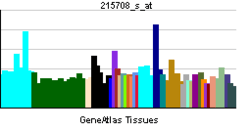PRIM2
| PRIM2 | |||||||||||||||
|---|---|---|---|---|---|---|---|---|---|---|---|---|---|---|---|
| |||||||||||||||
| Identifiers | |||||||||||||||
| Aliases | PRIM2, PRIM2A, p58, primase (DNA) subunit 2 | ||||||||||||||
| External IDs | MGI: 97758 HomoloGene: 731 GeneCards: PRIM2 | ||||||||||||||
| RNA expression pattern | |||||||||||||||
  | |||||||||||||||
| More reference expression data | |||||||||||||||
| Orthologs | |||||||||||||||
| Species | Human | Mouse | |||||||||||||
| Entrez | |||||||||||||||
| Ensembl | |||||||||||||||
| UniProt | |||||||||||||||
| RefSeq (mRNA) | |||||||||||||||
| RefSeq (protein) | |||||||||||||||
| Location (UCSC) | Chr 6: 57.31 – 57.65 Mb | Chr 1: 33.45 – 33.67 Mb | |||||||||||||
| PubMed search | [1] | [2] | |||||||||||||
| Wikidata | |||||||||||||||
| View/Edit Human | View/Edit Mouse |
DNA primase large subunit is an enzyme that in humans is encoded by the PRIM2 gene.[3][4]
The replication of DNA in eukaryotic cells is carried out by a complex chromosomal replication apparatus, in which DNA polymerase alpha and primase are two key enzymatic components. Primase, which is a heterodimer of a small subunit and a large subunit, synthesizes small RNA primers for the Okazaki fragments made during discontinuous DNA replication. The protein encoded by this gene is the large, 58 kDa primase subunit.[4]
References
- ↑ "Human PubMed Reference:".
- ↑ "Mouse PubMed Reference:".
- ↑ Shiratori A, Okumura K, Nogami M, Taguchi H, Onozaki T, Inoue T, Ando T, Shibata T, Izumi M, Miyazawa H, et al. (Feb 1996). "Assignment of the 49-kDa (PRIM1) and 58-kDa (PRIM2A and PRIM2B) subunit genes of the human DNA primase to chromosome bands 1q44 and 6p11.1-p12". Genomics. 28 (2): 350–3. doi:10.1006/geno.1995.1155. PMID 8530050.
- 1 2 "Entrez Gene: PRIM2A primase, polypeptide 2A, 58kDa".
Further reading
- Stadlbauer F, Brueckner A, Rehfuess C, et al. (1994). "DNA replication in vitro by recombinant DNA-polymerase-alpha-primase.". Eur. J. Biochem. 222 (3): 781–93. doi:10.1111/j.1432-1033.1994.tb18925.x. PMID 8026492.
- Maruyama K, Sugano S (1994). "Oligo-capping: a simple method to replace the cap structure of eukaryotic mRNAs with oligoribonucleotides.". Gene. 138 (1–2): 171–4. doi:10.1016/0378-1119(94)90802-8. PMID 8125298.
- Suzuki Y, Yoshitomo-Nakagawa K, Maruyama K, et al. (1997). "Construction and characterization of a full length-enriched and a 5'-end-enriched cDNA library". Gene. 200 (1–2): 149–56. doi:10.1016/S0378-1119(97)00411-3. PMID 9373149.
- Coll JM, Hickey RJ, Cronkey EA, et al. (1998). "Mapping specific protein-protein interactions within the core component of the breast cell DNA synthesome". Oncol. Res. 9 (11–12): 629–39. PMID 9563011.
- Schneider A, Smith RW, Kautz AR, et al. (1998). "Primase activity of human DNA polymerase alpha-primase. Divalent cations stabilize the enzyme activity of the p48 subunit". J. Biol. Chem. 273 (34): 21608–15. doi:10.1074/jbc.273.34.21608. PMID 9705292.
- Arezi B, Kirk BW, Copeland WC, Kuchta RD (1999). "Interactions of DNA with human DNA primase monitored with photoactivatable cross-linking agents: implications for the role of the p58 subunit". Biochemistry. 38 (39): 12899–907. doi:10.1021/bi9908991. PMID 10504261.
- Smith RW, Nasheuer HP (2002). "Control of complex formation of DNA polymerase alpha-primase and cell-free DNA replication by the C-terminal amino acids of the largest subunit p180". FEBS Lett. 527 (1–3): 143–6. doi:10.1016/S0014-5793(02)03197-6. PMID 12220650.
- Strausberg RL, Feingold EA, Grouse LH, et al. (2003). "Generation and initial analysis of more than 15,000 full-length human and mouse cDNA sequences". Proc. Natl. Acad. Sci. U.S.A. 99 (26): 16899–903. doi:10.1073/pnas.242603899. PMC 139241
 . PMID 12477932.
. PMID 12477932. - Mungall AJ, Palmer SA, Sims SK, et al. (2003). "The DNA sequence and analysis of human chromosome 6". Nature. 425 (6960): 805–11. doi:10.1038/nature02055. PMID 14574404.
- Gerhard DS, Wagner L, Feingold EA, et al. (2004). "The Status, Quality, and Expansion of the NIH Full-Length cDNA Project: The Mammalian Gene Collection (MGC)". Genome Res. 14 (10B): 2121–7. doi:10.1101/gr.2596504. PMC 528928
 . PMID 15489334.
. PMID 15489334. - Rush J, Moritz A, Lee KA, et al. (2005). "Immunoaffinity profiling of tyrosine phosphorylation in cancer cells". Nat. Biotechnol. 23 (1): 94–101. doi:10.1038/nbt1046. PMID 15592455.
This article is issued from Wikipedia - version of the 6/3/2016. The text is available under the Creative Commons Attribution/Share Alike but additional terms may apply for the media files.